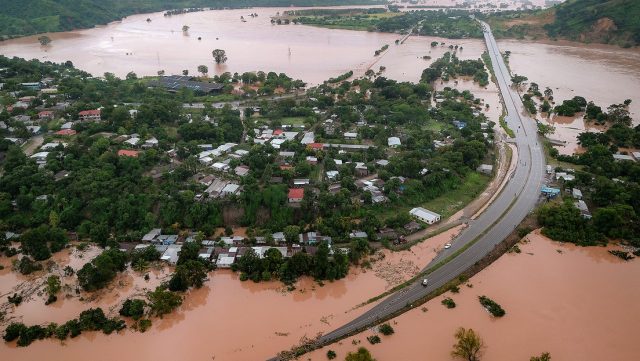The presence of the climatic phenomenon ‘La Niña’ in the American continent has caused natural disasters that in recent weeks have left dozens of dead, injured, missing and thousands of victims (that have lost their homes) throughout the region.
Abundant rains, accompanied by strong gusts of wind and electrical storms, generated by tropical depressions, cyclones and hurricanes, affect the Caribbean, northern South America, Central America and part of the North American territory.
Floods, landslides and waterlogging have been part of the destruction caused by nature in countries such as Venezuela, Colombia, Trinidad and Tobago, Cuba, Puerto Rico, Honduras, El Salvador, Guatemala, Panama, Mexico and the US.
In these countries, there has also been serious damage to public and private infrastructure, with thousands of homes destroyed. It has also affected industries and caused the loss of private property such as cars, transport vehicles and heavy trucks.
The material losses are multimillionaires and it also had an impact on sectors such as livestock, agriculture, drinking water services, telecommunications, and electricity, among others.
But ‘La Niña‘ is not just rain and flooding. In countries such as Argentina, Bolivia, southern Brazil, Chile, Paraguay, Peru and Uruguay, or in the Horn of Africa, it manifests itself in another way: an intense and prolonged drought that affects the generation of hydroelectric power, impacts against crops and food production, dries up rivers, lakes and wetlands, and produces extreme heat waves and wildfires.What is ‘La Niña’?
Part of the natural global climate cycle known as the El Niño Southern Oscillation (ENSO), the ‘La Niña’ event occurs when trade winds from the East intensify the flow of cooler water from the depths of the eastern tropical Pacific Ocean.
This causes a massive cooling of the surface of the eastern and central Pacific Ocean near the Equator, which can have a variable duration, between 9 months and 3 years, and generates changes in the tropical atmospheric circulation, which is evidenced by the increase in winds, pressure and precipitation, thus altering the global climate system, affecting multiple regions of the world that experience changes in their precipitation and temperature regimes.
‘La Niña’ is known by that name because it causes opposite effects to the ‘El Niño’ event, which consists of the unusual heating of the surface waters of the Equatorial Pacific and when it is ‘activated’, it produces severe droughts in the same regions where ‘ La Niña’ generates immense rainfall.
‘El Niño’ and ‘La Niña’ events, which are important determinants of the Earth’s climate system, are part of the recurring natural phenomena that have caused climate variability for thousands of years. However, in recent years, with global warming, both episodes have shown variations in both their frequency and intensity.
The World Meteorological Organization (WMO) notes that «all naturally occurring weather events» now occur in the context of climate change, causing «an increase in global temperatures, exacerbating extreme weather and climate events, and altering the configuration of seasonal temperatures and rainfall».An unprecedented episode for this century
At the end of last August, the WMO reported that this 2022 ‘La Niña’ could reach the first «triple episode» of this century. What does that mean? That the phenomenon currently being recorded can last until the end of the year, that is, its duration has been maintained for three consecutive winters in the northern hemisphere or three summers in the southern hemisphere.
So, the so-called «triple episode» occurs because since September 2020 the atmospheric conditions have allowed ‘La Niña’ to remain active in the tropical Pacific, reinforced by «the intensification of the trade winds recorded between mid-July and mid-August 2022».
In its latest bulletin on ‘El Niño/La Niña’, the WMO indicated that the probability that the current episode of ‘La Niña‘ will continue during the next six months is 70% until next November. However, the percentage drops to 55% for the months of December 2022 and February 2023.
«This has affected temperature patterns and precipitation patterns and exacerbated drought and flooding in different parts of the world», explained the WMO.
The WMO Secretary General, Petteri Taalas, noted in the WMO report that this episode of ‘La Niña’ «is exceptional» because it is difficult for the event to continue for three consecutive years. In addition, the cooling effect it causes «is temporarily slowing the rise in global temperatures, but will not stop or reverse the long-term warming trend», warned Taalas.
For example, the stay of the phenomenon has caused, in the Horn of Africa, the worsening of the drought, which will affect millions of people. The same thing happens in southern South America. In parallel, the heavy rainfall already observed in India, Indonesia, Bangladesh, among other countries in Southeast Asia and Australia, in northern South America, Central America and the Caribbean will intensify.
For now, the stay of ‘La Niña’ also increases the chances of storms and strong hurricanes such as Julia, which is advancing towards Mexico after causing damage in South America and Central America, as well as Ian and Fiona, which weeks ago left devastation in Puerto Rico, Cuba and the southern United States, a country that could receive heavy snowfall in the north at the end of the year.











